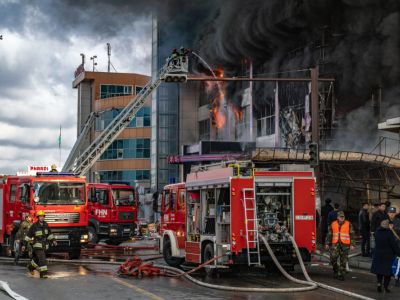The bow of the sunken nuclear submarine Kursk has been detached and final preparations are getting under way for the crucial operation that will bring the 20,000-tonne wreck to the surface, Russian naval officials said Thursday.
"The cutting work is over and the divers are dismantling the giant saw" used to cut away the sub's front section, an officer with the Northern Fleet told AFP.
Removing the mangled bow that houses the submarine's torpedoes was seen as an essential preliminary to the lifting operation. It was feared that the badly-damaged front section could have fallen off as the wreck was rising from the seabed 108 metres (350 feet) below the surface.
Divers have been working in the icy Arctic waters for two weeks using robot cutting gear to remove the bow for fears that it could break off when the rest of the submarine is lifted.
Technical problems with the large saw last weekend fed rumours that the lifting would be delayed until 2002, but these were dismissed by government officials.
"Currently the submarine is being surveyed by experts using remote-controlled cameras," the officer said on condition of anonymity.
Divers will now "seal" the front end of the wreck with a thick metal sheet to prevent more water entering during the lifting, thus destabilising the operation, he said.
The lifting is to be achieved by attaching steel cables to the Kursk by means of 26 holes that were cut into the hull during the first stage of the operation completed last month.
Cranes aboard a huge barge, Giant 4, will then winch the submarine slowly to the surface and then tow it to dry dock in the Kola Peninsula,
Salvage workers were originally given a September 15 deadline to begin the lifting operation proper, but this has been put back to September 25, the company in charge of the work, Mamoet-Smit of the Netherlands, has said.
The Giant 4 is due to arrive on September 19. Under the new schedule, the Kursk should arrive at Roslyakovo, near Murmansk, by September 28.
The time element is crucial because during the Arctic winter, due to settle in within the next few weeks, the darkness and frequent storms will make further salvage work impossible.
Fears have also been expressed concerning the safety of the operation with regard to the submarine's two nuclear reactors, which could cause an ecologicial disaster if they were to fall out during the lifting.
The Kursk sank to the bottom of the Barents Sea during a naval exercise on August 12 last year, with the loss of all 118 crewmembers. The cause of the disaster has still not been determined.
Western experts have said the sinking followed two unexplained explosions probably involving the submarine's torpedoes, but some Russian officials are maintaining that the Kursk may have collided with a Western submarine operating in Russian waters.
Experts believe that clues to the cause of the disaster may lie in the damaged bow, which is to be brought to the surface in a separate, Russian-organised operation at a later date -- SEVEROMORSK, Russia (AFP)
© 2001 Al Bawaba (www.albawaba.com)









